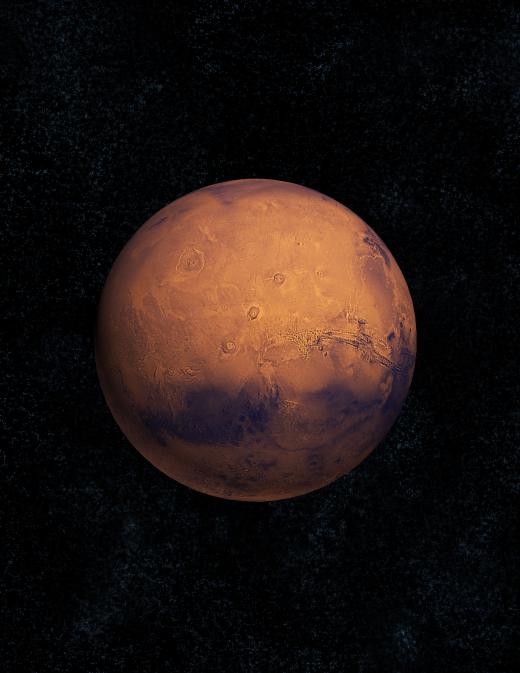What is the Largest Impact Crater in the Solar System?
 Michael Anissimov
Michael Anissimov
The largest known impact crater in the Solar System is a huge unnamed scar on the surface of Mars, 10,600 km long by 8,500 km wide. It is thought to have been created in the earliest ages of the Solar System, when a Moon-sized object nearly hit Mars, but instead scraped a deep scar in the planet. Something similar happened to the Earth, dislodging so much material that it later coalesced to create the Moon. These large impacts are thought to have been created by planetoids that formed in the Lagrange points, gravitational wells located in three other points in Earth's orbit. Mars also has its own Lagrange points.
The Mars scar is also considered the largest canyon in the Solar System, at about 25 times longer than the Grand Canyon. It is also the only confirmed canyon known to exist due to an encounter with a bolide (asteroid or planetoid) rather than water erosion or cracking of the surface due to native geological processes. The realization that the scar is an impact crater is fairly recent, published in Science only in 2008.

The second largest impact crater in the Solar System is the South Pole-Aitken basin on the Moon, at 2,500 km (1,553 mi) wide and 15 km (9.3 mi) deep. The impact crater was produced when a large comet or asteroid impacted the Moon during the Late Heavy Bombardment, a period of intense impact activity between 3800 and 4100 million years ago, where much of the debris from the formation of the Solar System was still in interplanetary space and had to find someplace to land. The South Pole-Aitken basin is one of the only impact craters in the solar system to be called a "basin" rather than a crater. The only impact crater of comparable size besides the one previously described is Hellas Planitina on Mars, about 2,300 km (1,429 mi) in extent. The South Pole-Aitken basin is the dominant feature of the far side of the Moon, acting as the most significant dent in the lunar highlands.
AS FEATURED ON:
AS FEATURED ON:











Discussion Comments
When you think about it, it's rather amazing that the earth hasn't been struck by a large asteroid or meteor in the last several hundred years. I know most of the stuff flying around out there falls apart as it enters our atmosphere, but there are so many chucks of rock flying around that at some point a big object is bound to hit earth and cause a major earth impact crater, or totally destroy the planet.
@Laotionne - The work that scientists do does help us to get a better picture of the world and its history, but you should also keep in mind that not all of the conclusions they come up with are 100 percent accurate. In a few years, another scientist or group of scientists may say exactly the opposite of what was published in the 2008 article about the Mars' impact crater.
They may tell us that the crater on Mars was actually caused by water and erosion at a time when water covered 60 percent of the planet. The average person isn't going to be able to dispute or confirm any of these "realizations" that scientists explain to us.
Right now, most of us believe the Grand Canyon was caused by years and years of erosion. One day, scientists may say that that too was caused by some type of impact.
This article says the Mars scar is the largest impact crater and that scientists have only recently realized that the crater was caused by something hitting the planet. That makes me wonder how they actually determined this. I find science fascinating in the way scientists can learn about things that happened so long ago and then predict how and why those events happened.
Post your comments